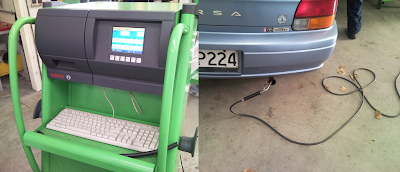The sensor is part of the emissions control system and feeds data to the ECU. The goal of the sensor is to help the engine run as efficiently as possible and also to produce as few emissions as possible.
A petrol engine burns petrol in the presence of oxygen. It turns out that there is a particular ratio of air and gasoline that is "perfect," and that ratio is 14.7:1 (different fuels have different perfect ratios -- the ratio depends on the amount of hydrogen and carbon found in a given amount of fuel). If there is less air than this perfect ratio, then there will be fuel left over after combustion. This is called a rich mixture. Rich mixtures are bad because the unburned fuel creates pollution. If there is more air than this perfect ratio, then there is excess oxygen. This is called a lean mixture. A lean mixture tends to produce more nitrogen-oxide pollutants, and, in some cases, it can cause poor performance.
The oxygen sensor is positioned in the exhaust pipe and can detect rich and lean mixtures. The mechanism in most sensors involves a chemical reaction that generates a voltage(see the patents below for details). The engine's computer looks at the voltage to determine if the mixture is rich or lean, and adjusts the amount of fuel entering the engine accordingly.
The reason why the engine needs the oxygen sensor is because the amount of oxygen that the engine can pull in depends on all sorts of things, such as the altitude, the temperature of the air, the temperature of the engine, the barometric pressure, the load on the engine, etc.
When the oxygen sensor fails, the computer can no longer sense the air/fuel ratio, so it ends up guessing. Your car performs poorly and uses more fuel than it needs to.
reference by http://www.howstuffworks.com
WS6 Oxygen Sensors on Vehicle
Make FORD Model KA Year ...............
1.0 Locate Oxygen Sensor
1.1 Locate an oxygen sensor on your vehicle. Describe where it is located:
The oxygen sensor is located the top of the exhaust manifold in front of the engine.
1.2 How many wires for this oxygen sensor? 4
1.3 Record the colours for each of the wires at the sensor side of the connector (not the ECU side of the connector). Then list the use of the wires. Usually a black or blue wire will be the O2 sensor signal, Grey may be the sensor ground. Heater power and ground are often white. But there may be other colours. You may have to consult a wiring diagram.
Colour Use or Purpose
White heater +
White heater -
Black signal positive
Gray signal ground
1.4 What type of Oxygen Sensor is this? (tick one)
Zirconia switching sensor? …√….
Titania switching sensor? …….
Broadband Air Fuel Ratio sensor? (one cell) …….
Broadband Air Fuel Ratio sensor? (two cell) …….
This worksheet is designed for switching type sensors only. If you have a broadband sensor, see your lecturer for another worksheet.
2.0 Back probe the Oxygen Signal Wire with a pin and connect to an oscilloscope. If you need help using the oscilloscope see your lecturer or other help sources. Check that you are connected to the Oxygen sensor signal: Run the engine and check that you are seeing a signal. Connected OK? Yes ……√…….
3.0 Watch and Record Oxygen Signal pattern at 2500 rpm. Let the engine warm up and enter closed loop so you see a normal cycling pattern. You may have to hold the rpm about 2500 for half a minute to go into closed loop.
3.1 Freeze your pattern and draw or photograph it onto the graph below: Note the voltage and time per division or scale next to the graph.

3.2 How high does the voltage go? 0.908 v
3.3 How low does the voltage go? 0.107 v
3.4 What is the average voltage? (Some oscilloscopes have functions that will calculate the average for you. If not, just guess.) 0.500 v
3.5 How many “Cross Counts” does the signal have in 10 seconds? (One cross count is when it goes from high to low, or from low to high.) List here: 14
3.3 How low does the voltage go? 0.107 v
3.4 What is the average voltage? (Some oscilloscopes have functions that will calculate the average for you. If not, just guess.) 0.500 v
3.5 How many “Cross Counts” does the signal have in 10 seconds? (One cross count is when it goes from high to low, or from low to high.) List here: 14
3.6 If the signal is not cycling normally, describe what the signal does:
OK 4.0 Watch and Record Oxygen Signal pattern at Idle rpm. Let the engine warm up and enter closed loop so you see a normal cycling pattern. You may have to hold the rpm about 2500 for half a minute to go into closed loop. Then let the RPM come down to idle.
4.1 Freeze your pattern and draw or photograph it onto the graph below: Note the voltage and time per division or scale next to the graph.
4.2 How high does the voltage go? 0.857 v
4.3 How low does the voltage go? 0.167 v
4.4 What is the average voltage? (Some oscilloscopes have functions that will calculate the average for you. If not, just guess.) 0.450 v
4.5 How many “Cross Counts” does the signal have in 10 seconds? (One cross count is when it goes from high to low, or from low to high.) List here: 6
OK
5.0 Make this Oxygen Sensor go rich by accelerating once or twice. (The fuel system should normally make the system go rich when you do a sudden acceleration.) Push on the accelerator quickly but don’t let the rpm go high enough to hurt the engine. (If you act like you will hurt the engine you will be asked to leave lab.) The signal should go over 0.85V.
5.1 Freeze your pattern as it goes rich and draw or photograph it onto the graph below: Note the voltage and time per division or scale next to the graph.
5.2 How high does the Oxygen sensor voltage go? 0.859 v
5.3 If this signal is not going high normally, describe what the signal does:
OK
6.0 Make this Oxygen Sensor go lean by doing a sudden deceleration. Gently run the rpm up to about 3,000, and let the RPM drop suddenly. The fuel system should make the system go lean on deceleration. The signal should go below 0.2V.
6.1 Freeze your pattern as it goes rich and draw or photograph it onto the graph below: Note the voltage and time per division or scale next to the graph.
5.3 If this signal is not going high normally, describe what the signal does:
OK
6.0 Make this Oxygen Sensor go lean by doing a sudden deceleration. Gently run the rpm up to about 3,000, and let the RPM drop suddenly. The fuel system should make the system go lean on deceleration. The signal should go below 0.2V.
6.1 Freeze your pattern as it goes rich and draw or photograph it onto the graph below: Note the voltage and time per division or scale next to the graph.
6.1 How low does the Oxygen sensor voltage go? 0.131 v
6.2 If this signal is not going low normally, describe what the signal does:
OK
7.0 Measure the Response Time of the sensor. You want to know that the sensor can respond quickly to changes in the exhaust gas. The best way is to do a sudden acceleration, freeze the pattern, and measure how long it took the sensor to go from lean to rich.
7.1 Freeze your pattern as it goes suddenly rich from a lean condition and draw it into the graph below: Normally you want the voltage to go from below 0.2V to above 0.8V. in less than 100 ms. Note the voltage and time per division or scale next to the graph.
7.2 Measure how long the sensor took to go from lean to rich. Use the cursers on the scope if necessary. Record how long the sensor took here: 100 ms
8.0 Discuss how a normal Zirconium oxygen sensor works: draw a picture below to help show how it works?
The output signal of oxygen sensor informs the vehicle’s ECU (Electronic Control Unit) whether the Air/Fuel Ratio is lean(below 0.2 v) or rich(above 0.8 v). Based on this, the ECU adjusts the amount of fuel injected into the engine to achieve an optimal air/fuel ratio.







